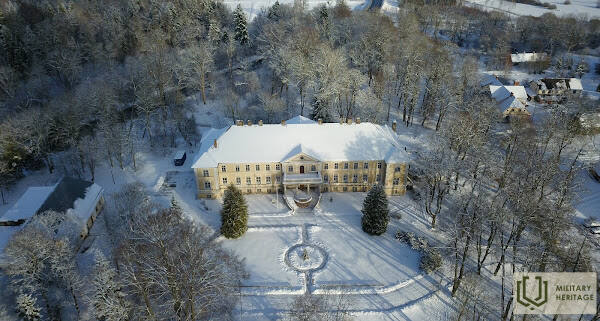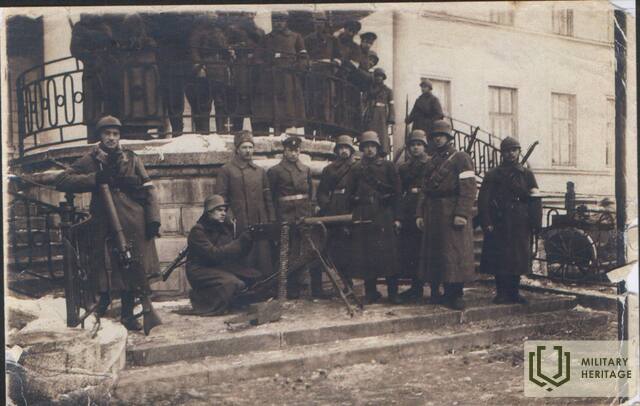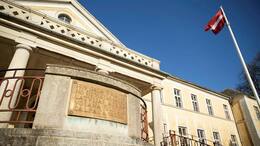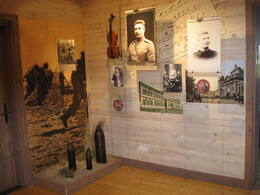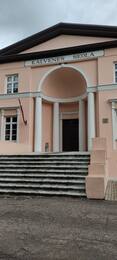General Ridiger von der Goltz's visit to Rudbārži in February 1919
In February 1919, after a successful anti-German campaign in Finland, German General Ridiger von der Goltz was appointed commander of the German armed formations in Courland and Northern Lithuania, including the Landwehr, which included the 1st Latvian Battalion. During his visit to the front in February 1919, he also arrived in Rudbārži. Lieutenant Jānis Ķīselis, the battalion's special task officer, described the General's visit in his memoirs.
Having received news of the expected guest, the colonel (Oskars Kalpaks.ed.) ordered a proper roast of roe deer to be cooked so that there would be something to welcome him. In the castle courtyard, students were lining up for training (Soldiers of the Separate Student Company.ed.) and the other boys, free from duty, were riding around them. Somewhere nearby, a car roared by. The colonel ordered me to go out and meet the guest at the door, but he himself remained inside. Our people, who happened to be nearby, greeted the approaching general properly, but no common command was heard. General Count von der Goltz got out of the car with a staff officer. That's what this famous warrior and savior of Finland looked like. Tall, gray-haired, stately build, he left an imposing impression.
We greeted each other, I stood in front and asked the guests to come in. The general's forehead furrowed into furrows - the old Prussian aristocrat did not like, did not like very much the reception at the headquarters of Latvian peasant warriors. And he probably also knew about our conversations with the Obersthof about his visit. When we entered, Colonel Kalpaks came towards us through the anteroom. The two men closely observed each other's gaze, greeted each other and the colonel led the general on.
In the small, round office, the two guests sat on one side of the table, the colonel with Captain Balodis on the other, and I at the head of the table, because the colonel did not speak German. After brief, informative questions about our forces and the situation at the front, von der Golz went straight to the matter that was closest to him and hurt him the most. He had been informed about our mobilization announced in Tāši-Padure (Mūsdēnas Kalvene. ed.) and that the colonel had sent officers to some parishes to call on the people to come to our aid. The general immediately began to speak in a rather agitated voice, that he was the one in charge of all the armed forces in this territory and that he could not allow any mobilizations, because all Latvians were Bolsheviks and if we mobilized them, then later he would no longer be able to be sure that they would not fall on the backs of his units. Under no circumstances could such mobilized people be sent against the Red Army, because they would immediately cross over to the other side. Colonel Kalpaks just as energetically rejected these statements and, for his part, emphasized that the Latvian people were ready to fight against the bigots, only they themselves, the Germans, were hindering and obstructing it in every way. A spark of evil flashed in the count's eyes; he probably had not expected such determined resistance to his intentions here. They discussed a few more questions about our supplies and the general attack ahead. On the whole, the count was not very satisfied with the talks, he tasted very little of the lunch we offered and soon set off. When we went outside, von der Golz turned to me and said indifferently: "I don't trust the Letten." As if foreseeing future times, I answered without hesitation: "Neither do I, Herr Count." I later found an explanation for the Count's frankness in his book "Meine Sendung in Finnland und im Baltikum", in which, writing about this visit, he mentions that Col. Kalpak had a clever adjutant and translator - a half-Jew. So my crooked nose had provoked the general's frankness. Thus ends this first and last visit of von der Goltz to the Latvian headquarters.
When we had gone on a long reconnaissance walk, we often went to bathe in the manor bathhouse, and this sport was most respected by Col. Kalpaks. At first we went with him, later we tried to get to the bathhouse either before or after him, because the colonel always brought down such a spirit that the others only crawled and tried to get out into the front room. When Kalpaks had thoroughly cooled down, he threw himself from the bathhouse at full speed into a deep snowdrift, thoroughly rolled through it and then went back into the bathhouse. By nature, our leader was very simple and could not tolerate any ostentation. There were few punishments, but strict friendly discipline reigned. As a curiosity, I remember the following case: our "dzhigit" captain Zariņš had either torn off his old trousers, or else had let them go, and had imagined that a pair of decent trousers could be made from the dust of the billiard table in Rudbārži Castle. Without thinking much, he had torn off the dust and fashioned a very luxurious suit with his own hands and walked around with a green bottom like a parrot. He didn't have to wear it for long, though, because he soon got a good thrashing from the colonel and two hours under the sword (Type of punishment. ed.).
Kīselis J. In the Fight for the Homeland. Riga, 1936.
Related timeline
Related objects
Rudbārži Manor Castle and memorial plaque to the 1st Latvian Separate Battalion
The castle is located in Rudbārži, on the Riga - Liepāja A9 highway. A memorial plaque commemorating the deeds of Oskars Kalpaka's battalion is placed in front of the building.
The castle was built in 1835 as a property of the Baron von Firks family on the order of Baroness Thea von Firks. On 15 December 1905 the manor house was burnt down by revolutionaries. Restoration work under the direction of architect L. Reiniers began three years later.
During the Latvian War of Independence, Rudbārži Castle served as a base and headquarters for combat operations on the banks of the Venta River, commanded by Colonel Oskars Kalpaks' 1st Separate Latvian Battalion.
Later, the castle was used as a recreation base for Latvian army soldiers. In 1938 the castle was rebuilt.
During the Second World War the building housed a hospital for German army soldiers, and in the post-war years - a school for forest workers. In 1962 the castle became the Rudbārži School, which was named after Oskars Kalpaks in 1991. The Hall of Heroes of Rudbārži Manor was restored in 2016. The school is currently closed, but in the coming years the building is planned to house a vocational military secondary school named after Oskars Kalpaks.
Oskars Kalpaks Museum and Memorial Site “Airītes”
The Oskars Kalpaks Museum and Memorial Site Airītes is located between Saldus and Skrunda near the A9 highway. The exhibit has extensive information about Colonel Oskars Kalpaks and his battalion, and shows the history of the Latvian National Army and the memorial site Airītes. The exhibit reveals Colonel Oskars Kalpaks as a personality, as a soldier and as a fighter for Latvia's independence. Audio logs in Latvian, English and German are also available as part of the exhibit. They emphasize the importance of the historic events of 1918/1919 in the protecting the statehood of Latvia. The museum building has been restored.
Entry is free; guided tour – for a fee. The complex has a recreation area, a park, an obstacle course, it is possible to take various classes, and there is a seminar hall for up to 30 people.
Tāšu - Padure Manor
The Tasi - Padure Manor Castle is now known as Kalvene Primary School, founded in 1922. The school building was built in the 19th century in the late classical style as a hunting lodge for Count Keizerling.
At the beginning of 1919, the first mobilised men who answered the call for mobilisation gathered here and came to the manor. On 22 January 1919, the Latvian Separate Cavalry Unit was established here, one of whose leaders went to the 1st Latvian Separate Battalion commanded by O.Kalpaks on 24 January. The whole unit (about 80 soldiers in total) under the command of commander Arnolds Artum-Hartmanis arrived in Rudbārži on 1 March.
Kalvene Primary School is a national cultural monument. In the 1960s, the castle was renovated and adapted to the needs of the school.




